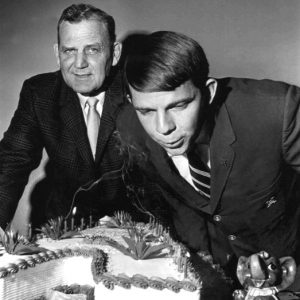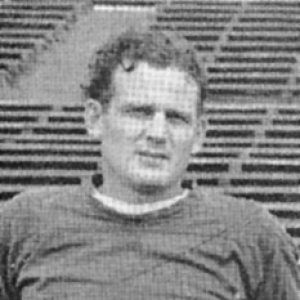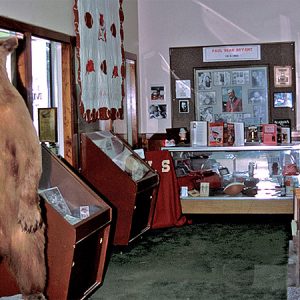calsfoundation@cals.org
"Bear" Bryant (1913–1983)
aka: Paul William Bryant
Paul William “Bear” Bryant is one of America’s all-time most successful college football coaches. At the time of his death, he had won more games than any other coach, including the legendary Amos Alonzo Staggs and Pop Warner. Arkansas-born Bryant remains an icon not only for athletic accomplishments but for personal strength, determination, and the will to win.
Paul William Bryant was born on September 11, 1913, near Kingsland (Cleveland County) in south-central Arkansas, to William Monroe Bryant, a farmer, and Dora Ida Kilgore Bryant, a homemaker. Bryant was the eighth surviving child (three died at birth) of a total of nine. He had four brothers and four sisters and was the youngest boy, with one sister born four years after him. Their home was a three-square-mile area called Moro Bottom (sometimes referred to as Moro Bottoms), an unincorporated place where seven families lived.
Due to his father’s ill health and the family’s poverty, Bryant often stayed with his grandfather, W. L. Kilgore, in nearby Fordyce (Dallas County), where he discovered football, playing for the Fordyce High School Redbugs (often at Redbug Field). In 1927, he entered a contest at the Fordyce Theatre promising a dollar to anyone who could wrestle a bear. The teenage Bryant was never paid but acquired the nickname “Bear.”
His 1930 Fordyce team had a perfect season and claimed an Arkansas high school football state championship. An assistant coach from Alabama came to Fordyce in 1931 to scout two other players, who decided to go to the University of Arkansas in Fayetteville (Washington County), and ended up signing Bryant to an athletic scholarship for the University of Alabama.
As an Alabama player, Bryant helped his team win the Southeastern Conference (SEC) championship during the SEC’s inaugural season in 1933, playing right offensive end. During a 1935 game against Tennessee, Bryant led Alabama to a 25–0 victory despite playing with a broken bone in his leg. That same year, he married campus beauty queen Mary Harmon Black, with whom he had two children, Mae Martin and Paul Jr. Before graduating from the University of Alabama in 1936, Bryant played in the Rose Bowl and helped his team claim the national title.
In 1941, after coaching at Union College (now Union University in Jackson, Tennessee) and Vanderbilt University, Bryant was on his way to Arkansas, where he was being considered to be head coach of the University of Arkansas Razorbacks, when he heard that World War II had begun. He promptly enlisted in the Navy rather than join the Razorbacks. After his military service, he coached football at universities including Maryland, Kentucky, and Texas A&M, where his legend grew in a game when his Aggies trailed 12–0 in the final two minutes yet still managed to win. Bryant had told his team there was still time for them to win if they believed they could, and they went on to score twenty unanswered points, winning the game.
In 1958, Bryant began his twenty-five year tenure as head coach of the University of Alabama. Under Bryant, the Alabama Crimson Tide won national titles in 1961, 1964, 1965, 1978, and 1979. Bryant won this last championship with a perfect season, including his defeat of Lou Holtz’s Arkansas Razorbacks in the Sugar Bowl. He announced his retirement in 1982, with the Crimson Tide winning his last bowl game, the Liberty Bowl in Memphis, on December 29. His record at Alabama was 232–46–9, with his team playing in twenty-four consecutive post-season bowl games. Bryant was Southeastern Conference Coach of the Year ten times, a three-time National Coach of the Year, and he received one and a half votes for the Democratic presidential nomination at the 1968 Chicago, Illinois, convention. His overall coaching record was 325–85–17.
Less than one month after winning the 1982 Liberty Bowl, sixty-nine-year-old Paul “Bear” Bryant died of a heart attack on January 26, 1983. Following a funeral procession which ran for three miles, he was buried at Elmwood Cemetery in Birmingham, Alabama. A month after his death, he was posthumously awarded the Presidential Medal of Freedom, the nation’s highest civilian award, by Ronald Reagan. At the time of his death, he was the all-time most successful coach in American college football history.
On September 27, 2024, the Division of Arkansas Heritage placed a marker at the New Edinburg (Cleveland County) home where Bryant spent the early years of his childhood.
For additional information:
Barra, Allen. The Last Coach: A Life of Paul “Bear” Bryant. New York: W. W. Norton, 2005.
Briley, John David. Career in Crisis: Paul “Bear” Bryant and the 1971 Season of Change. Macon, GA: Mercer University Press, 2006.
Bryant, Paul W., and John Underwood. Bear: The Hard Life and Good Times of Alabama’s Coach Bryant. Chicago: Triumph Books, 2007.
Cain, Jesse. “Marker Unveiled for ‘Bear’ Bryant.” Arkansas Democrat-Gazette, September 28, 2024, pp. 1B, 2B. Online at https://www.arkansasonline.com/news/2024/sep/27/historical-marker-placed-near-fordyce-for-boyhood/ (accessed September 30, 2024).
Dunnavant, Keith. Coach: The Life of Paul “Bear” Bryant. New York: Simon & Schuster, 1996.
Herskowitz, Mickey. The Legend of Bear Bryant. New York: McGraw-Hill, 1986.
Puma, Mike. “Bear Bryant ‘Simply the Best There Ever Was.” ESPN Classic. http://espn.go.com/classic/biography/s/Bryant_Bear.html (accessed July 25, 2023).
Roberts, Randy, and Ed Krzemienski. Rising Tide: Bear Bryant, Joe Namath, and Dixie’s Last Quarter. New York: Twelve, 2013.
Nancy Hendricks
Arkansas State University
 Recreation and Sports
Recreation and Sports World War II through the Faubus Era, 1941 through 1967
World War II through the Faubus Era, 1941 through 1967 "Bear" Bryant
"Bear" Bryant  "Bear" Bryant
"Bear" Bryant  "Bear" Bryant Exhibit
"Bear" Bryant Exhibit 



In 2013, Bear Bryant still held the record as the youngest college football coach to win 300 games and compile 30 winning seasons.
My grandmother, Fern Kilgore Nutt of Fordyce, was Paul Bryants cousin. A few years before she passed away in 2006, she told me that he was very shy as a young man until he discovered football while walking past Redbug Field in Fordyce. His self-esteem was so low that hed cross the street to avoid talking when he saw someone he knew approaching, even a family member like her. After he became a football player and found pride in being part of a team and in his athleticism, that all changed. My grandfather, Harry Sadie Nutt, played with Paul on the championship teams at Fordyce High School. The local newspaper described him as 150 pounds of dynamite at offensive end, while Paul, who was bigger and stronger, played on the offensive line. I recall meeting Paul once at my grandmothers house when he was visiting Fordyce during the off-season. He signed a bit of paper for me, and I walked out to his car with him. I was a big kid for my age and had played a little football in a teeny league in Little Rock. He gripped my shoulder, sizing me up, and said in that gravelly voice, I hope youll come play football for me at Alabama someday, son. The memory still gives me chills. A couple of years ago, I was talking football with a new friend who said hed met Paul at some function when he too was about 11 or 12. Paul gripped his shoulder in the exact same way and told him to come play football for him at Alabama when he grew up, too! Theres no telling how many times he went through those motions, knowing that few of those kids would ever make it. But what a wonderful gift he gave to so many of us who remember those encounters with a legendary coach!